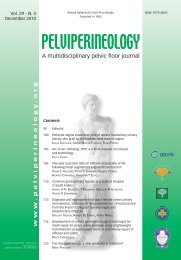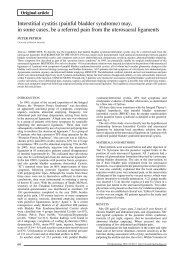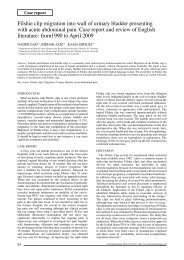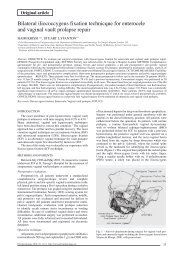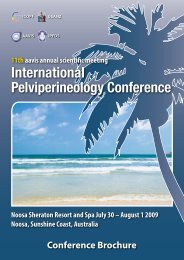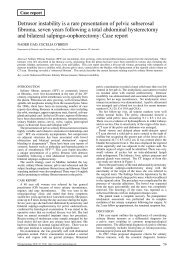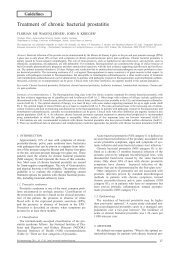This Issue Complete PDF - Pelviperineology
This Issue Complete PDF - Pelviperineology
This Issue Complete PDF - Pelviperineology
You also want an ePaper? Increase the reach of your titles
YUMPU automatically turns print PDFs into web optimized ePapers that Google loves.
Original article<br />
Material and type of suturing of perineal muscles<br />
used in episiotomy repair in Europe<br />
VLADIMIR KALIS - JIRI STEPAN Jr. - ZDENEK NOVOTNY - PAVEL CHALOUPKA<br />
MILENA KRALICKOVA - ZDENEK ROKYTA<br />
Department of Obstetrics and Gynecology, University Hospital, Faculty of Medicine, Charles University, Alej Svobody 80, 304 60 Plzen, Czech Republic<br />
Abstract: None of the trials evaluating episiotomy repair clearly focused on perineal muscles. The aim of this study was to describe suture<br />
material and styles of suturing perineal muscles in Europe by using an email and postal questionnaire. From 34 European countries, 122 hospitals<br />
agreed to participate. Thirteen different types of sutures are currently used. The most common material is polyglactin 910 (70%) followed<br />
by polyglycolic acid. Fifty one hospitals (46%) use only short-term and 49 hospitals (44%) use only mid-term absorbable synthetic sutures. In<br />
8 hospitals both types of sutures were used. The most common size of suture is 2-0 USP. Thirty percent of hospitals use continuous and 47%<br />
hospitals interrupted sutures for perineal muscle repair. In 23% of the hospitals there is not a uniform policy. The technique of suturing perineal<br />
muscles is diverse in Europe. It is unclear whether short-term absorbable synthetic suture should substitute mid-term absorbable synthetic<br />
material in the perineal muscle layer.<br />
Key words: Episiotomy; Practice variation; Perineum/Surgery; Episiorrhaphy; Suture technique.<br />
INTRODUCTION<br />
Episiotomy, the incision of the perineum during the last<br />
part of the second stage of labour or delivery is still considered<br />
a controversial procedure. Long-term complications<br />
after episiotomy repair are common. A large proportion<br />
of women suffer short-term perineal pain and up to 20%<br />
have longer-term problems (e.g. dyspareunia). 1 Other complications<br />
involve the removal of suture material, extensive<br />
dehiscence and the need for resuturing. 2<br />
According to an Italian study, episiotomy is associated<br />
with significantly lower values in pelvic floor functional<br />
tests, both in digital tests and in vaginal manometry, in comparison<br />
with women with intact perineum and first- and<br />
second-degree spontaneous perineal lacerations. 3 In another<br />
prospective trial of 87 patients, the pelvic floor muscle<br />
strength, assessed with the aid of vaginal cones, was significantly<br />
weaker in the episiotomy subgroup compared to a<br />
subgroup with spontaneous laceration. 4 A German study did<br />
not reveal any difference in the pelvic floor muscle strength<br />
between groups with restrictive and liberal use of episiotomy.<br />
5 None of these trials are specific about the type of<br />
suturing material used.<br />
Some of the trials evaluating episiotomy and its consequence<br />
regarding suturing material, focus on the type of<br />
sutures and a technique used for suturing the superficial<br />
layers (skin or subcuticular). 6<br />
If mid-term absorbable polyglycolic acid sutures were<br />
used for repairing perineal muscles, a comparison to catgut<br />
7, 8, 9, 10<br />
or chromic catgut 11, 12 was usually made.<br />
One trial compared mid-term absorbable polyglycolic acid<br />
(Dexon II) with a new monofilament suture glycomer 631<br />
(Biosyn). 13 There were significantly more problems associated<br />
with monofilament material at 8-12 weeks postpartum<br />
(suture removal due to discomfort and pain) which might be<br />
explained by the longer absorption time of glycomer 631. 13<br />
In a recent trial, in which only a short-term absorbable<br />
polyglactin 910 (Vicryl RAPIDE) is used, a continuous<br />
suture is compared to an interrupted technique and a continuous<br />
suture is found to be superior. 14<br />
To our knowledge, three trials have compared short- and<br />
mid-term synthetic absorbable suturing material. 15, 16, 17 In<br />
these, either only a standard mid-term absorbable polyglactin<br />
910 (Coated Vicryl) or only a short-term absorbable<br />
polyglactin 910 (Vicryl RAPIDE) was used for all layers<br />
(vaginal mucosa, perineal muscles, subcuticular/skin). All<br />
<strong>Pelviperineology</strong> 2008; 27: 17-20 http://www.pelviperineology.org<br />
of them focused on perineal pain and short-term complications<br />
of the repair and did not follow the pelvic floor muscle<br />
function.<br />
A small Danish randomized control trial (RCT) showed<br />
no difference in short- and long-term perineal pain, with<br />
a reduction in pain when walking on day 14 in a Vicryl<br />
RAPIDE group. Also, no difference was found between<br />
groups regarding episiotomy dehiscence. 15<br />
An Ulster study compared the same materials (Coated<br />
Vicryl and Vicryl RAPIDE).16 78 women were completed<br />
after birth with Coated Vicryl and 75 with Vicryl RAPIDE.<br />
At six and twelve weeks, a significant difference in the<br />
rates of wound problems (infection, gaping, pain, material<br />
removed) was found in favor of Vicryl RAPIDE. 16<br />
Kettle et al. performed a very well designed RCT with<br />
1542 women. 17 These were randomized into groups where<br />
either a standard mid-term absorbable polyglactin 910<br />
(coated Vicryl) or a short-term absorbable polyglactin 910<br />
(Vicryl RAPIDE) was used. The sutures of the perineal<br />
muscles and the skin were either, only interrupted, or only<br />
continuous, non-locking. The vaginal mucosa was always<br />
sutured continuously. <strong>This</strong> trial shows a clear benefit of the<br />
continuous technique compared to the interrupted. The pain<br />
at day 2, 10 and onwards up to 12 months postpartum was<br />
significantly lower in the continuous group. Also, all the<br />
other followed parameters (suture removal, uncomfortability,<br />
tightness, wound gaping, satisfaction with the repair and<br />
a return to normality within 3 months) were in favor of the<br />
continuous technique. 17<br />
Comparing the standard mid-term absorbable and shortterm<br />
absorbable polyglactin 910, in the parameter which differed<br />
most (suture removal), if sutures needed to be removed<br />
only visible transcutaneous sutures were removed from the<br />
continuous group. So the rate for suture removal, which was<br />
significantly lower for those who had received short-term<br />
absorbable polyglactin 910, is related to vaginal mucosa or<br />
skin and not to the sutures of perineal muscles. 17<br />
Pain at day 10 was not significantly different; however,<br />
some secondary pain measures (pain walking) were significant.<br />
17 The reduction in pain is achieved by inserting the<br />
skin sutures into the subcutaneous tissue and so avoiding<br />
nerve endings in the skin surface. 18 So the difference at<br />
day 10 might be explained by a different rate of absorption<br />
between Vicryl RAPIDE and Coated Vicryl and irritating<br />
nerve endings in the skin (and not in the muscles) by<br />
the remaining Coated Vicryl sutures. Vicryl RAPIDE is<br />
17



